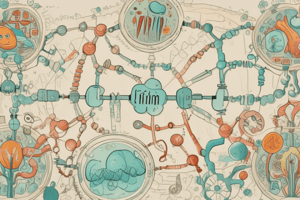Podcast
Questions and Answers
What is a consequence of decreased production related to dopamine?
What is a consequence of decreased production related to dopamine?
- Parkinson’s disease (correct)
- Increased melanin synthesis
- Albinism development
- Enhanced fight-or-flight response
What does melanin result from in melanocytes?
What does melanin result from in melanocytes?
- Oxidation of Dopa (correct)
- Hydrolysis of glutamine
- Degradation of catecholamines
- Oxidation of tyrosine
Which receptors does epinephrine primarily act upon to induce its effects?
Which receptors does epinephrine primarily act upon to induce its effects?
- Delta and beta receptors
- Alpha and beta receptors (correct)
- Delta and gamma receptors
- Alpha and gamma receptors
Which of the following hormones is synthesized from tyrosine by the thyroid gland?
Which of the following hormones is synthesized from tyrosine by the thyroid gland?
What is the main role of serotonin in the body?
What is the main role of serotonin in the body?
Which neurotransmitter is produced through the decarboxylation of glutamate?
Which neurotransmitter is produced through the decarboxylation of glutamate?
Which product is derived from tryptophan and is associated with the regulation of sleep-wake cycles?
Which product is derived from tryptophan and is associated with the regulation of sleep-wake cycles?
What is the primary function of the excitatory neurotransmitter glutamate?
What is the primary function of the excitatory neurotransmitter glutamate?
What causes nonketotic hyperglycinemia?
What causes nonketotic hyperglycinemia?
Which amino acid is crucial in the synthesis of creatine?
Which amino acid is crucial in the synthesis of creatine?
What is the primary purpose of measuring creatinine excretion in urine?
What is the primary purpose of measuring creatinine excretion in urine?
Which of the following diseases is associated with deficiencies in enzymes involved in heme synthesis?
Which of the following diseases is associated with deficiencies in enzymes involved in heme synthesis?
What is the role of dopamine in the body?
What is the role of dopamine in the body?
Which starting materials are used in heme synthesis?
Which starting materials are used in heme synthesis?
Which of the following catecholamines is produced from L-Dopa?
Which of the following catecholamines is produced from L-Dopa?
What leads to severe mental deficiencies and potentially early death in individuals with nonketotic hyperglycinemia?
What leads to severe mental deficiencies and potentially early death in individuals with nonketotic hyperglycinemia?
What is the primary consequence of phenylketonuria (PKU)?
What is the primary consequence of phenylketonuria (PKU)?
Which enzyme deficiency is associated with alkaptonuria?
Which enzyme deficiency is associated with alkaptonuria?
What is the primary symptom of alkaptonuria?
What is the primary symptom of alkaptonuria?
What causes cystinuria?
What causes cystinuria?
How is the progression of gyrate atrophy primarily managed?
How is the progression of gyrate atrophy primarily managed?
Which of the following describes a complication associated with cystinuria?
Which of the following describes a complication associated with cystinuria?
Which compound accumulates in the urine of individuals with PKU?
Which compound accumulates in the urine of individuals with PKU?
What is the genetic basis of gyrate atrophy?
What is the genetic basis of gyrate atrophy?
What type of amino acids are those that can directly supply gluconeogenesis?
What type of amino acids are those that can directly supply gluconeogenesis?
Which amino acid is classified as both glucogenic and ketogenic?
Which amino acid is classified as both glucogenic and ketogenic?
What are the products obtained from the degradation of phenylalanine?
What are the products obtained from the degradation of phenylalanine?
What role does tetrahydrobiopterin (BH4) play in the metabolism of phenylalanine?
What role does tetrahydrobiopterin (BH4) play in the metabolism of phenylalanine?
What disease is caused by a mutation in the gene that encodes phenylalanine hydroxylase?
What disease is caused by a mutation in the gene that encodes phenylalanine hydroxylase?
During the degradation of lysine, which enzyme plays an important role?
During the degradation of lysine, which enzyme plays an important role?
Which of the following is a potential fate of the carbon skeletons of amino acids after nitrogen removal?
Which of the following is a potential fate of the carbon skeletons of amino acids after nitrogen removal?
What is the function of dihydrobiopteridine reductase in the metabolism of phenylalanine?
What is the function of dihydrobiopteridine reductase in the metabolism of phenylalanine?
Flashcards are hidden until you start studying
Study Notes
Amino Acids and Their Metabolism
- Amino acids can either be glucogenic or ketogenic due to the fate of their carbon skeletons after nitrogen removal.
- Glucogenic amino acids are degraded to pyruvate or citric acid cycle intermediates.
- Ketogenic amino acids are degraded to acetyl CoA or acetoacetate.
- Some amino acids can be both glucogenic and ketogenic, like phenylalanine and tyrosine.
Lysine Degradation
- Lysine is a ketogenic amino acid.
- Saccharophine dehydrogenase (LYS1) is the key enzyme in lysine degradation.
- LYS1 uses NADP+ and glutamate as cofactors.
Phenylalanine Degradation and Phenylketonuria (PKU)
- Phenylalanine is both glucogenic and ketogenic.
- PKU is a genetic disorder caused by a deficiency in phenylalanine hydroxylase.
- This leads to the accumulation of phenylalanine in the blood, which cannot be converted to tyrosine.
- Elevated phenylalanine levels can inhibit brain development.
Alkaptonuria
- Alkaptonuria is a genetic disease caused by a lack of homogentisate dioxygenase (HGD).
- This leads to the accumulation of homogentisic acid (HGA) in the body.
- Symptoms include black urine, ochronosis (black bones and cartilage), and degenerative arthritis.
Branched-Chain Amino Acid Metabolism
- α-keto acid dehydrogenase deficiency is the most common enzyme abnormality in branched-chain amino acid catabolism.
Other Diseases of Amino Acid Metabolism
- Cystinuria: Defects in kidney transport of cysteine and basic amino acids lead to cysteine accumulation, forming cystine stones.
- Gyrate Atrophy: Deficiency in ornithine transaminase activity causes a loss of vision due to damage to the choroid and retina.
- Nonketotic Hyperglycinemia: Defects in glycine cleavage enzyme lead to excessive glycine accumulation, causing severe metabolic deficiencies.
Amino Acids in the Body
- Amino acids are used in the synthesis of many important compounds.
Heme Synthesis
- Glycine and succinyl CoA are starting materials for heme synthesis.
- Deficiencies in heme synthesis enzymes lead to porphyrias.
Creatine Synthesis
- Creatine is synthesized from arginine and glycine.
- Creatinine, a catabolic product of creatine, is excreted in the urine.
- Creatinine levels reflect glomerular function.
Catecholamine Synthesis
- Catecholamines are synthesized from phenylalanine.
- Catecholamines include: L-dopa, norepinephrine, and epinephrine.
Clinical Implications of Catecholamine Synthesis
- Dopamine, a neurotransmitter derived from L-dopa, is depleted in Parkinson's disease.
- Melanin, a pigment produced from L-dopa, is deficient in albinism.
- Epinephrine and norepinephrine, "fight-or-flight" hormones, are synthesized from tyrosine.
Thyroid Hormone Synthesis
- The thyroid gland produces triiodothyronine (T3) and tetraiodothyronine (T4) from tyrosine.
Tryptophan Metabolism
- NAD(P) is synthesized from tryptophan.
- Serotonin, a neurotransmitter, is also derived from tryptophan.
- Melatonin, a hormone involved in daily rhythms, is synthesized from tryptophan.
Neurotransmitters from Glutamine
- Glutamine is hydrolyzed to glutamate, an excitatory neurotransmitter.
- Glutamate is decarboxylated to GABA, an inhibitory neurotransmitter.
Studying That Suits You
Use AI to generate personalized quizzes and flashcards to suit your learning preferences.



